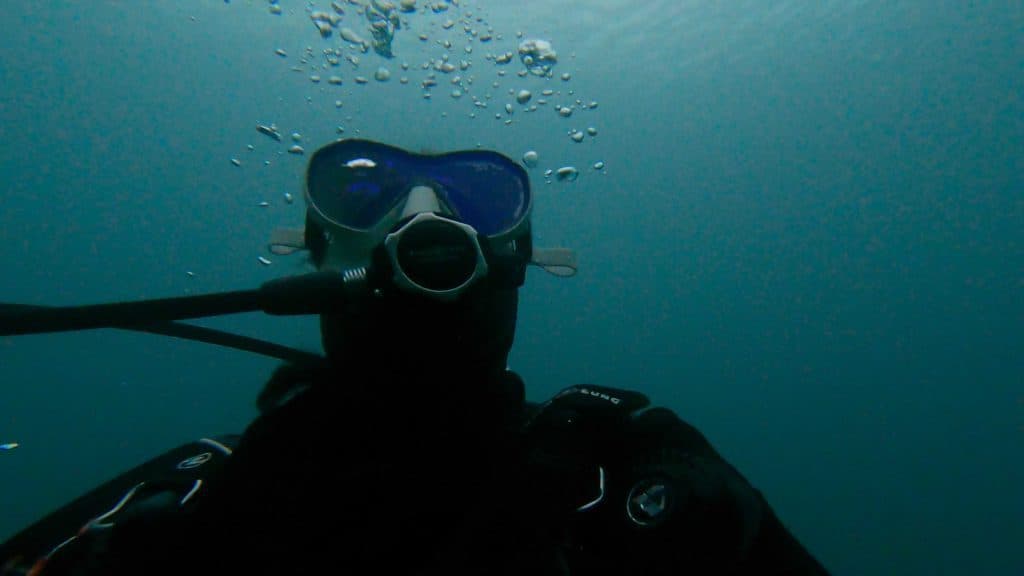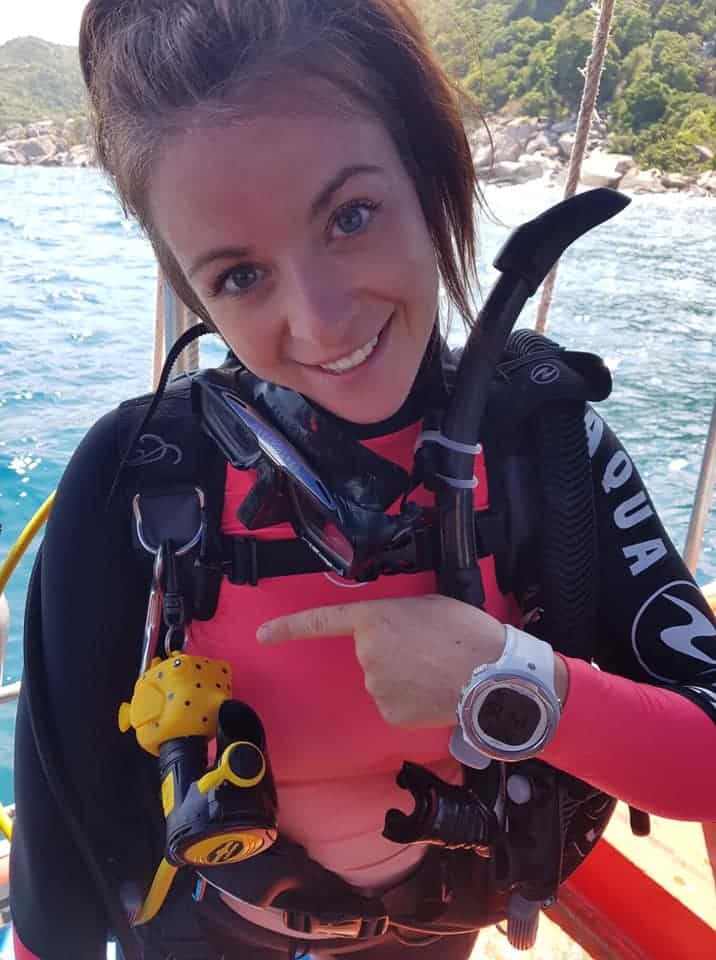It may not be for everyone, but it’s something that everyone should try at least once in their life. Cold water diving is a popular sport, and differs quite a bit from warm water diving. Don’t get me wrong, I love diving in warm waters just as much as the next person, but there is something about being immersed in cold water that provides a great sense of achievement.
And these are my reasons;
- Explore unique ecosystems
- Experience better visibility
- Push outside of your comfort zone
- Try new equipment
- Lower your blood pressure
Table of Contents
What is Cold Water Diving?
Cold water dives are, quite simply, any dive that takes place in colder waters. This can be in cold freshwater environments like quarries or lakes, to saltwater environments like areas of the ocean far away from the equator.
Cold water dives also differ to warm water dives by requiring a more specialised equipment set up and exposure protection. With the colder waters, we need to make sure that our equipment can function safely in lower temperatures and that our exposure suits can keep us warm.

Diving in cold water can open up a whole new world, especially if you are only used to being warm underwater! It can be a challenge – our dive gear is often bulkier and our dive times can be considerably shorter. But cold water diving pushes you outside of your comfort zone and brings with it a whole load of new and memorable experiences!
Is Cold Water Diving Dangerous?
Like any type of scuba diving, cold water diving has its risks. The main hazard that we find here, but don’t commonly find in warm water diving, is to ensure we maintain our body temperature and stay warm. There is an increased risk of hypothermia when diving in cold water and if we don’t do our best to mitigate this risk, then our dive could turn dangerous quick.
Therefore, when learning to dive in cold water environments, there is a large focus on exposure protection such as dry suits and the problems and hazards that may be encountered when using this type of equipment. Using a drysuit is one way of reducing the risk of hypothermia. A drysuit can help you remain warm underwater by keeping a layer of air trapped in between the suit and your body, but I will go into this more below as there is a fair bit more to it than this.
Reasons Why Everyone Should Try Cold Water Scuba Diving
I never thought I would become a fan of winter diving, or even diving in cold waters in general. Believe it or not, I did my PADI Dry Suit Speciality very soon after completing my Advanced Diver course in Thailand. I returned to England and thought “why not give it a go?!”. I then soon found myself diving in February, in water that was 4 degree celcius, in a quarry in Yorkshire.
It is now something that I tell everyone they must try!
Below are just a few suggestions as to why cold water scuba diving should be on every ones bucket list.
Explore Unique Ecosystems

There are all sorts of marine ecosystems across our world, many of which are only found in cold water locations. This means that the marine life you see on a cold water dive differs greatly from the marine life that would be found on a warm water dive. In fact, cold water dive locations do have some of the most exciting and charismatic species, that divers travel from all over the world to see. They are often a very unique aquatic environment.
From spotting catsharks in the kelp beds off the coast of the UK, diving with sea lions in the Pacific and penguins in the Antarctic, to being in the water with Orcas in Norway, there are some INSANE marine life encounters to just waiting to be had.
But if it’s not only marine life you’re after, cold waters have their fair share of wrecks and ruins to explore too. Over the years they have grown to become their own unique ecosystems and are often much less visited than their warm water counterparts!
If your in the UK, then there’s lots on our doorstep that you may not have realised before! Have a read of my best diving in the UK for a sneak peak into some of our most treasured sites. I promise you, this is just the tip of the iceberg!
Better Visibility

The environmental conditions, including the visibility, can really make or break a dive. Yes there are some wonderful tropical destinations that regularly have great visibility, but there are some beautiful cold water spots that are world renowned for their spectacular visibility.
Take the Silfra Fissure in Iceland, for example. This site is well known for allowing divers to scuba in two continents at once where the North American and Eurasian tectonic plates meet. But that isn’t the only reason why this dive site is on so many divers bucket list. The visibility here is often more than 100 metres – that’s over 300 feet!
With visibility like this, it’s easy to forget that you are even underwater!
Push Outside of your Comfort Zone

We really are a species of comfort. I don’t believe that this has been a part of our evolutionary history until very recently. With the advancement of technology and convenience, it is often easy to remain in a cycle of comfort and familiarity.
I am a firm believer that when we push outside of our comfort zone, with whatever challenge that may be, we can reap an array of unexpected benefits. Cold water is not a comfortable place to be. Not immediately anyway. There has been a lot of research into cold water therapy in recent years and we now know that their are numerous physiological and psychological benefits to cold exposure. Now, I’m certainly not encouraging you to dive without the suitable exposure protection, but feeling that cold water rush over your face as you descend whilst you focus on your breathing does create a calm and focused state of mind.
Not only that, it’s important, as divers, that we continue to improve on skills we know but also learn new skills. Taking the PADI Dry Suit Speciality is a great way to continue your diving education.
If you are a regular cold water diver and are looking for that next step – why not give ice diving a go?!
Try New Equipment

Hands up if you love new dive equipment?! Cold water diving requires equipment that can function safely in lower temperatures. Our regulators, for example, need to be approved for cold water use. The first stage of these regulators often have environmental seals– dry-sealed spring chambers – which prevent freezing and prevent the reg from freeflowing. I use my Aqualung Legends in both cold and warm water environments and the environmental seal in the first stage helps me dive safely.
Don’t toss warm dry clothes to one side! Wearing a drysuit as opposed to a wetsuit will not only improve your bodies ability to maintain a good temperature, it will also allow your clothes to stay dry! Just as important as the drysuit, is the under layers you choose to use. I recommend looking into investing in a good set of thermal base layers, that you can layer up and down to suit changes in temperature throughout the year.
Your dry suit will enable you to stay dry and control your buoyancy. Some offer good thermal protection properties. There are many different materials that dry suits can be made out of, some with higher thermal properties than others. Take crushed neoprene, for example. Suits that are made from crushed neoprene offer better thermal protection due to the special preparation of the neoprene, enabling tiny little enclosed air bubbles to form. A trilaminate suit will offer no thermal protection, so thermal undergarments are a must.
I dive with my crushed neoprene Hydrotech Predator 2. This is a UK manufactured suit which I absolutely love. It is surprisingly lightweight, fits in all the right places and keeps me dry and warm. Hydrotech can custom make these dry suits to different needs and I also opted for a few add on’s such as kevlar knee pads, attached hard soul boots and a neoprene neck seal. The Predator 2 also incorporates a layer of titanium into the material to help insulate and retain body temperature as well as protecting against wear.
Lower Your Blood Pressure

Jumping into a cold dive site where the air temperature is higher than the water temperature will immediately initiate a physiological change in the body. When our body is floating in cold water, our blood vessels towards the surface of our skin constrict which helps conserve the heat for our internal organs such as those towards our core. This can cause our heart rate to increase and requires a good focus on breath work to help lower it back down. This phenomonom is known as the diving reflex, aka diving bradycardia. Once our bodies begin to warm up and adjust to the lower temperature and changing conditions, both our heart rate and blood pressure decreases.
If you have never tried scuba diving before, but are now keen to take the plunge, make sure you take a read of my what beginners should know about scuba diving blog.
Before you are able to qualify as a dry suit diver, you will need to take your PADI Open Water Course.
What Do Divers Wear in Cold Water?

Cold water divers generally wear a semi-dry wetsuit or a drysuit with thermal undergarments, a hood and gloves.
It is important to try on a few different dry suits to ensure that they fit well. The last thing you want is a leak, and only discovering it once you’re on your dive. Check out the different types of drysuit available, such a trilaminate and crushed neoprene and see what you would feel most comfortable in. Try them on, compare them and even give them a test in your bath or local pool. Get in contact with your local dive shop and see what they recommend, they may also let you try them on in a pool before buying.
A good pair of gloves and hood are a lifesaver. I love my Fourth Element 5mm Hydrolock dive gloves and my Fourth Element 5mm dive hood. They are super comfy on, and don’t feel too restrictive but work wonders at keeping my head and hands warm!
Don’t forget that your undergarments are just as important. Fourth Element do a great range of layer thermal protection. These clothes worn beneath will help a diver stay warm and retain most of the heat that the body is producing. I recently invested in the O’Three PBB eXtreme Base Layer system (see photo above) which has really increased my toastiness by more than a bit!
How Do Scuba Divers Stay Warm?
The combination of a well fitting drysuit, good quality thermal undergarments, hood and gloves will ensure that divers stay warm when scuba diving in cooler waters.
Don’t forget that maintaining your body heat during your surface interval is equally as important as staying warm whilst in the water. Make sure that you have warm clothing, dry gloves, a ski jacket or similar with a nice, warm hat. Oh, and a tasty hot chocolate!

